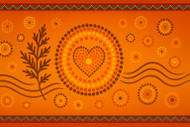Truth & Reconciliation: Supporting Indigenous Art
Posted by J. Hartung on Sep 29, 2025
On September 30, Turtle Island Market pauses to honour Survivors of residential schools, the children who never returned home, and all families and communities affected. For us, truth and reconciliation is not a one-day event—it’s a commitment to listen, learn, remember, and act.
Art is one way we live that commitment. It carries memory, ceremony, humour, language, and land—often in the same image. Below, we share what this day means, how Indigenous art contributes to healing and education, and practical ways you can support Indigenous creators year-round.
What this day means—and why it matters
The National Day for Truth and Reconciliation exists to:
-
Centre Survivors’ voices and the truths they’ve shared.
-
Acknowledge harms caused by colonial policies, including residential schools.
-
Move from awareness to action: changing how we learn, work, buy, and build relationships.
You’ll also see orange shirts on September 30. The orange shirt has become a powerful symbol that “Every Child Matters,” reminding us that children’s lives, languages, and cultures must be cherished and protected.
How art advances truth & reconciliation
Indigenous art isn’t just décor—it’s story, sovereignty, and livelihood.
-
Truth-telling: Visual art can communicate histories and feelings that words alone can’t.
-
Language & place: Motifs and techniques carry teachings tied to community and land.
-
Economic reconciliation: Buying from Indigenous artists and businesses keeps value in community, funds future work, and builds intergenerational opportunity.
-
Education: Art opens doors for difficult conversations in classrooms, workplaces, and homes.
Our practice at Turtle Island Market
At Turtle Island Market, we share original Indigenous designs—including Métis dot art inspired by land, wildlife, and community. Our commitments include:
-
Authenticity & consent: We foreground Indigenous artists and keep control of designs with them.
-
Fair pay: Transparent, equitable compensation for artists and collaborators.
-
Giving back: Allocating a portion of proceeds from selected collections to Indigenous-led initiatives focused on language, youth, and land stewardship.
-
Education with respect: Context pages that explain artwork stories without disclosing teachings that are not ours to share.
Reconciliation is a verb. We track our actions, measure impact, and update our community annually.
7 meaningful actions you can take today
-
Buy directly from Indigenous artists and businesses. Choose authentic work with clear artist attribution.
-
Amplify safely. Credit the artist when you share their work; don’t remove watermarks.
-
Learn with intention. Attend local events or talks led by Knowledge Keepers and Survivors when available.
-
Support youth & language programs. Donations and volunteer time matter.
-
Review your workplace procurement. Advocate for policies that prioritize Indigenous vendors and fair contracts.
-
Educators & parents: Add Indigenous artists to your classroom/home libraries—ensure resources are age-appropriate and created or reviewed by Indigenous people.
-
Make it year-round. Put one action in your calendar each month (buy, learn, donate, volunteer, or hire).
Ethical buying guide (quick checklist)
-
Who made it? Look for the artist’s name, Nation/affiliation, and story.
-
Who benefits? Confirm royalties/fair pay and Indigenous ownership.
-
Cultural respect: Some designs are ceremonial or not for general use—when in doubt, ask.
-
Materials & sustainability: Choose items that honour land as well as story.
Artist spotlight: Métis dot art
Dot work in our collection reflects connections among land, kinship, movement, and memory. Each piece is built dot by dot—like beads on a sash—creating living patterns that honour place while welcoming contemporary colour and form. You’ll see references to local wildlife, seasonal light, and waters that carry our stories.
FAQ
Is September 30 a statutory holiday everywhere in Canada?
It’s a federal statutory holiday. Observance by employers and public institutions can vary by province/territory—check local guidance for specifics.
What’s the connection between Orange Shirt Day and this day?
Orange Shirt Day and the National Day for Truth and Reconciliation occur on the same date. The orange shirt honours Survivors and the children who never returned home, centring the message that Every Child Matters.
How can non-Indigenous allies support respectfully?
Listen, learn from Indigenous-led sources, credit artists, avoid appropriated designs, and act within your circles (schools, workplaces, teams) to change policies and purchasing.

